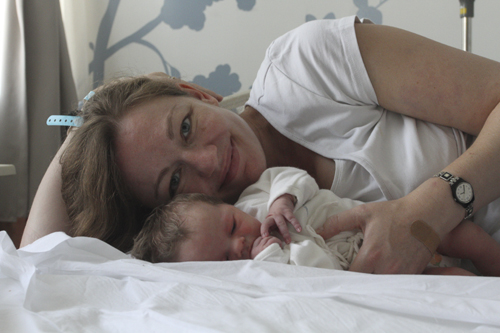
It’s the kind of shocking tabloid front-page that stops you in your tracks: “Woman Gives Birth in Speeding Mercedes.” But behind the lurid, attention-grabbing headline, the Happrich family’s story has relevance for all parents. It’s certainly an extreme situation, one you’ll hopefully never find yourself in, and probably unlikely to be repeated in our community. But like all boundary cases, it can teach us something about the importance of preparing for the worst, and hoping for the best. Even if the worst turns out to be delivering in the back of a car!
Preparing for birth isn’t just about what you hope will go right; it’s also about contingency planning for what can go wrong. The more informed the couple, the more comprehensive their understanding, the less frightening inevitable deviations from their blueprint will be, and the quicker they can adjust to shifting circumstances and adapt to the birth as it unfolds. Kerstin Happrich tells beijingkids the incredible story of her daughter Anni’s birth, and her Obstetrician/Gynecologist (OB/GYN) Dr. Alejandra Mora of International SOS explains how couples can best prepare for pregnancy’s checkered-flag.
Anni’s Birth
The Happrich family moved to Beijing from Stuttgart, Germany in 2012 for work. They brought with them their daughter Ella (now age 4) and wanting to give her a sibling, became pregnant again in late 2013 with their daughter Anni (now 1). During her pregnancy, Kerstin saw Dr. Mora at International SOS, and decided to give birth at Beijing United Family Hospital (BJU). First time births generally last 6-18 hours and subsequent births are generally between 2-10 hours. Older sister Ella’s birth had been a little protracted and required medical intervention; although Kerstin’s water broke, she felt no contractions, and after 12 hours she was induced. Anni’s birth was her sister’s diametric opposite: the whole labor lasted a mere 30 minutes.
"I never expected that leaving my neighbors’ I was 10 minutes
away from giving birth!"

Kerstin woke on the morning of August 13, 2014 at around 5am. “There was some water, and I thought, ‘It’s going to start.’ In the shower I felt a little pain, but I was grateful that I was feeling contractions, unlike Ella’s birth,” she says. Having no way of knowing how foreshortened the birth would be, the Happrichs were not particularly rushed or hurried in their movements. “I wasn’t worried. From my previous experience I thought the birth would take hours, so I finished my shower and then we packed. I thought I would need distractions,” she laughs. Dirk, who worked at Daimler in Beijing, even loaded a huge yoga ball into their company car, an E-Class Mercedes.
The Happrichs timed the contractions, and knew they needed to go to BJU, without grasping how little time they had to accomplish that. Dirk dropped Ella into a neighbor’s house. Outside in the passenger seat of their Mercedes, a sharp pain overwhelmed Kerstin. “I was experiencing intense pains every 30 seconds to 1 minute. I didn’t realize they were delivery contractions,” she says. “It took us around 15 minutes to get out of our house, and 5 minutes to drop off Ella. I never expected that leaving my neighbors’ I was 10 minutes away from giving birth!”
Kerstin felt that something was badly wrong. Before they drove away she switched to the back seat. From there she urged Dirk to drive faster. “But he was already driving as fast as he could,” she says. “I thought I wouldn’t survive the pain, and I had no idea what to do. I was trying to work against the contractions and hold the baby until we reached the hospital.” Fortunately the words of a midwife from an antenatal class she took came back to her. “She had said that you should never fight contractions; you should always go with them, no matter what.”
Ella’s car seat was still fitted in the back seat, and prevented Kerstin from lying down. Kerstin took off her underwear and shoes. Holding onto the handle above the door, with one leg over the car seat and one in the foot well, she began working with the pain. Meanwhile, still driving at speed, Dirk’s frantic phone calls to BJU introduced a note of black comedy. As he anxiously sought advice and support, the receptionist, clearly not understanding the urgency and gravity of their situation, repeatedly asked for Kerstin’s birth date so she could check their insurance details. “It was like a horror movie,” says Kerstin. “We both felt totally helpless. As I was fighting pain, they asked him five times for the insurance information.”
While on the phone, Dirk looked over his shoulder and was startled to see the baby crowning. “I am a modern person, and I automatically thought I had to give birth in a hospital, with a doctor, or the baby would die,” says Kerstin. “But there is no way to fight the forces of nature. We should’ve pulled over earlier, but there was no time to think, and no one to guide us. Our preprogrammed target was to reach the hospital.”

In the still speeding Mercedes, the remarkable moment of delivery arrived. “Anni jumped out,” says Kerstin. “Thank God I was wearing a skirt. The material caught her and prevented her from falling off the seat into the foot well. Suddenly there was a blue baby lying there, curled in a ball like a hedgehog.”
The Happrichs knew from an earlier ultrasound that the umbilical cord would be wrapped around Anni’s neck. Dirk pulled the car over to the side of the highway, and came to help unwind the cord. “He couldn’t reach from the door, so I took her and unwound it. Anni was breathing and making small sounds, so slippery I almost couldn’t hold her,” says Kerstin. “We didn’t try to cut the umbilical cord. We had had enough adventure for one day!” She wrapped Anni up to keep her warm, and the Happrichs resumed their drive to BJU.

BJU staff were waiting in the hospital parking lot, and a nurse cut the cord in the car. Kerstin, who couldn’t walk, was stretchered into the hospital, and a nurse took the baby. “And from there, the story went on as usual,” says Kerstin. Because Anni’s birth was fast, Kerstin suffered almost no tearing. She delivered the afterbirth, as staff washed and checked Anni, who weighed in at a bouncing 3.5kg, and had suffered no ill effects from the location (or velocity) of her makeshift labor room. Kerstin and Anni spent the next three days in the comfort of the hospital.

“Anni is a healthy, peaceful little girl, who loves to smile,” says Kerstin. “Now I can laugh about it and it’s just a story to tell.” And what a story!
Preparing for Birth
Dr. Mora trained as a doctor and OB/GYN in her native Venezuela where she gained experience in emergency, inpatient, and outpatient settings. Most recently she was a field doctor with Medicins San Frontiers in rural Zambia, before coming to Beijing to work at International SOS three years ago.

Dr. Mora emphasizes that much of the preparation necessary for birth happens gradually as pregnancy progresses. Informing the woman of the physiological changes her body is undergoing, which indicate that she will be physically prepared for labor, helps women develop confidence and is a key part of antenatal consultations. “None of this is rocket science, and we’ve been doing it for millennia,” says Dr. Mora. Basic birth preparations for parents-to-be include having the aforementioned regular antenatal consultations, reading up on pregnancy and delivery, setting money aside, sleeping as much as they can, exercising, and eating healthily.
Another common way to prepare – one as old as humanity itself – is talking to other parents, and hearing their stories, experience, and guidance on managing the challenges of labor, birth, and early parenting. Dr. Mora stresses that although anecdotal information is useful, it’s not always representative. “One woman’s easy nine months should not mean that a woman who struggles with vomiting the whole first trimester should worry, and vaginal delivery is not superior to C-sections,” she says. “Each woman and each pregnancy is different. But there will be commonalities too.”
It’s also important for women to discuss their needs with their partners in advance, and that partners listen rather than assume. “You would be surprised how many couples have not had a frank and open discussion about these issues,” Dr. Mora says.
As for packing, Dr. Mora says that although it depends on the hospital and the woman, in general, “not much is needed other than clothes for mother and baby, reading material, music, patience, and a sense of humor. And maybe some diapers.”
"Plans are just plans.
When labor starts, things can change quickly"
Birth Planning
A birth plan identifies and sets out everything a woman needs to feel safe and confident during childbirth. The formalized process of defining a plan provides an opportunity for women to discuss with their hospital, doctors, partners, relatives, or friends what supports they need. It helps women to be actively involved in decision-making, and in setting expectations for what will happen during labor and delivery. “Obviously, nothing can be set in stone,” says Dr. Mora. “It is a living document which can be updated as circumstances change.”
A typical plan might discuss pain management and whether to use an epidural; what the parameters will be for scheduling a C-section; and the environment – who and what will be present. “All of this, of course, must be done within the guidelines of what is medically safe and appropriate,” says Dr. Mora. “We never put the mother or her baby at risk. Plans are just plans. When labor starts, things can change quickly.”
The ultimate goal is the same for every family: a healthy baby, and a healthy mother. Dr. Mora emphasizes that it’s important to keep this in mind, rather than focusing heavily on birth plan specifics. “However, talking about these things beforehand and making a plan is a very good way to minimize the risks of misunderstandings,” she says.
Maternity Hospitals
Beijing HarMoniCare Women and Children’s Hospital (HMC) 北京和美妇儿医院
Daily 8am-5pm (hospital hours), daily 5-10pm (pediatrics evening hours). A2 Xiaoguan Beili, Beiyuan Lu, Chaoyang District (6499 0000, contact@hmcare.org) www.hmcare.net
朝阳区北苑路小关北里甲2号
Beijing United Family Hospital (BJU) 北京和睦家医院
Daily 9am-5pm. 2 Jiangtai Lu, Chaoyang District (5927 7000, 24hr emergency: 5927 7120) www.ufh.com.cn
朝阳区将台路2号
OASIS International Hospital 北京明德医院
Mon-Fri 9am-6pm, Sat 8.30am-12.30am, daily 24hr emergency care. 9 Jiuxianqiao Beilu, Chaoyang District, Chaoyang District (400 UR OASIS) www.oasishealth.cn
朝阳区酒仙桥北路9号
Outpatient Antenatal Care
International SOS 北京国际救援中心
Daily 8am-8pm. Suite 105, Wing 1, Kunsha Building, 16 Xinyuanli, Chaoyang District (6462 9112, 24hr hotline 6462 9100, customerservicebj@internationalsos.com) https://www.internationalsos.com/clinicsinchina/en/Beijing.aspx
朝阳区新源里16号琨莎中心1座105室
Dr. Mora’s Recommended Resources:
Books:
Mayo Clinic Guide to a Healthy Pregnancy by experts at the Mayo Clinic
What to Expect When You’re Expecting by Heidi Murkoff
Websites:
www.lamaze.org
www.babycenter.com
This article originally appeared on page 24-27 of the beijingkids November 2015 issue. Click here to read the issue for free on Issuu.com. To find out how you can get your own copy, email distribution@truerun.com.
Photos: Courtesy of Victoria Boland, Kerstin and Dirk Happrich, and International SOS



